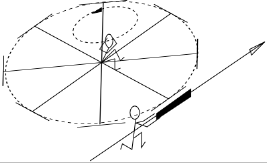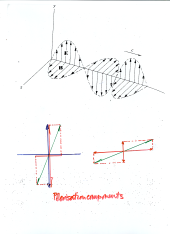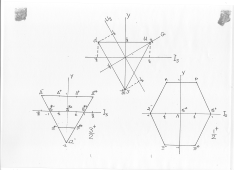Fundamental Physics and the Nature of Reality
This is a ten-lecture course offered periodically by DACE (last in 2004-5, and also on the internet in
session 2000-1). This page is a placeholder for that course,
as well as being a resource for folk who have done the course
in the past.
 I have two, partly conflicting, aims in this
course. The first is to give you a hint of what physics has to
say about how Nature works, at its most fundamental level, which
I hope to do by describing a number of areas of modern physics,
concentrating on the picture they give us of the universe's
workings. Although I will mention such exotica as black holes
and superstrings, I will spend little time discussing them.
Instead, I will concentrate on relativity and quantum mechanics,
because these topics are, I believe, genuinely intelligible in
outline without mathematics, and because they form a crucial
part of the world-view of 20th-century physicists. This will
shade into the second aim of the course, which is a more
philosophical consideration of what it means to have a `picture'
of reality, to what extent we can say that there is an
independent reality out there, and on what grounds science can
claim a privileged insight into this reality.
I have two, partly conflicting, aims in this
course. The first is to give you a hint of what physics has to
say about how Nature works, at its most fundamental level, which
I hope to do by describing a number of areas of modern physics,
concentrating on the picture they give us of the universe's
workings. Although I will mention such exotica as black holes
and superstrings, I will spend little time discussing them.
Instead, I will concentrate on relativity and quantum mechanics,
because these topics are, I believe, genuinely intelligible in
outline without mathematics, and because they form a crucial
part of the world-view of 20th-century physicists. This will
shade into the second aim of the course, which is a more
philosophical consideration of what it means to have a `picture'
of reality, to what extent we can say that there is an
independent reality out there, and on what grounds science can
claim a privileged insight into this reality.
The notes for the course were distributed on paper at the
course meetings, but are also available here for registered students
on the course (in versions for printing double-sided,
single-sided and reading on screen). You will need the password
I announced in the meetings. I have no plans to make these
notes generally available.
I mentioned that I also have notes available for second-year
Special Relativity (at http://purl.org/nxg/text/special-relativity)
and General Relativity (at http://purl.org/nxg/text/general-relativity).
You are welcome to these notes (the first
has moderate maths, the second is rather advanced).
Images: I've scanned two of the (few) overheads I've used.
 First, the model of classical polarisation (PNG, 373kB) shows
the undulatory model which represents the classical picture of
electromagnetic radiation (that is, light, radio waves and so
on). This is the model which Maxwell's equations describe so
successfully. This picture shows a pure monochromatic wave --
light in general would be composed of a jumble of waves of
different wavelengths and orientations. In this model, the
electric and magnetic fields oscillate in planes perpendicular
to each other, and if we say that a wave is polarised, we mean
that all the electric fields are aligned in one plane. When we
pass such a wave through a polariser (such as a sheet of
polaroid film), the polariser transmits the component of the
incoming wave which is parallel to the polariser's preferred
axis, and absorbs the other.
First, the model of classical polarisation (PNG, 373kB) shows
the undulatory model which represents the classical picture of
electromagnetic radiation (that is, light, radio waves and so
on). This is the model which Maxwell's equations describe so
successfully. This picture shows a pure monochromatic wave --
light in general would be composed of a jumble of waves of
different wavelengths and orientations. In this model, the
electric and magnetic fields oscillate in planes perpendicular
to each other, and if we say that a wave is polarised, we mean
that all the electric fields are aligned in one plane. When we
pass such a wave through a polariser (such as a sheet of
polaroid film), the polariser transmits the component of the
incoming wave which is parallel to the polariser's preferred
axis, and absorbs the other.
 The other image (PNG, 479kB) is of the baryon octet and
decaplet. In a broadly similar way to what Medeleev did with
the periodic table, Murray Gell-Mann discovered that a suitable
choice of parameters caused certain groups of particles to fall
into rather symmetric patterns (this is almost certainly a
caricature of the actual history of this development). The
quantities Y and Q are the `hypercharge'
(related to the `strangeness' of the particle) and the electric
charge; the other quantum numbers I3
(`isospin') and U3 shown here are of more
mathematical significance. The diagram shows on the right the
eight baryons with spin 1/2 and positive `parity' (this
group includes the proton and neutron), and on the left the ten
with spin 3/2 and positive `parity'. The particles with
the same hypercharge (for example the neutron and proton in the
1/2+ octet) in the have approximately the
same mass, and the mass difference between rows is approximately
the same in each diagram. The Omega-minus was unknown at the
time Gell-Mann first produced this diagram, and from it he was
able to predict the spin, parity, charge, strangeness and
approximate mass of the new particle.
The other image (PNG, 479kB) is of the baryon octet and
decaplet. In a broadly similar way to what Medeleev did with
the periodic table, Murray Gell-Mann discovered that a suitable
choice of parameters caused certain groups of particles to fall
into rather symmetric patterns (this is almost certainly a
caricature of the actual history of this development). The
quantities Y and Q are the `hypercharge'
(related to the `strangeness' of the particle) and the electric
charge; the other quantum numbers I3
(`isospin') and U3 shown here are of more
mathematical significance. The diagram shows on the right the
eight baryons with spin 1/2 and positive `parity' (this
group includes the proton and neutron), and on the left the ten
with spin 3/2 and positive `parity'. The particles with
the same hypercharge (for example the neutron and proton in the
1/2+ octet) in the have approximately the
same mass, and the mass difference between rows is approximately
the same in each diagram. The Omega-minus was unknown at the
time Gell-Mann first produced this diagram, and from it he was
able to predict the spin, parity, charge, strangeness and
approximate mass of the new particle.
I gave a compressed version of parts of this course as part of
Astronomy in the Third
Millennium.
Another variant was a talk at a DACE day-course on Dark Energy organised by Martin Hendry in November 2003.
There wasn't a handout for that, but my overheads are
available as a PDF file
I gave a variant of this course -- radically compressed into
two hours -- at the Borders Astronomy Club in 2000, and these
notes are available here as PDF files, in three versions, for
printing out double-sided or single-sided, or for reading on-screen. Let me
know if you have any problems with the files.
$Log: index.html,v $
Revision 1.11 2005/08/14 16:13:11 norman
Remove editing junk
Revision 1.10 2005/08/14 16:07:19 norman
Change the tense of the page, to refer to it in the past.
Revision 1.9 2004/12/13 20:18:40 norman
Add links to conclusions document
Revision 1.8 2004/11/25 10:13:04 norman
Added links to part4 downloads
Revision 1.7 2004/11/22 11:16:12 norman
Added scans of polarisation and quarks overheads
Revision 1.6 2004/11/10 17:37:11 norman
Added part3 notes
Revision 1.5 2004/11/07 22:01:35 norman
Include a pointer to the updated part two notes.
Revision 1.4 2004/10/22 08:57:56 norman
Added a note about the rescheduled meeting, on Tuesday 16 November
Norman
$Date: 2005/08/14 16:13:11 $
 I have two, partly conflicting, aims in this
course. The first is to give you a hint of what physics has to
say about how Nature works, at its most fundamental level, which
I hope to do by describing a number of areas of modern physics,
concentrating on the picture they give us of the universe's
workings. Although I will mention such exotica as black holes
and superstrings, I will spend little time discussing them.
Instead, I will concentrate on relativity and quantum mechanics,
because these topics are, I believe, genuinely intelligible in
outline without mathematics, and because they form a crucial
part of the world-view of 20th-century physicists. This will
shade into the second aim of the course, which is a more
philosophical consideration of what it means to have a `picture'
of reality, to what extent we can say that there is an
independent reality out there, and on what grounds science can
claim a privileged insight into this reality.
I have two, partly conflicting, aims in this
course. The first is to give you a hint of what physics has to
say about how Nature works, at its most fundamental level, which
I hope to do by describing a number of areas of modern physics,
concentrating on the picture they give us of the universe's
workings. Although I will mention such exotica as black holes
and superstrings, I will spend little time discussing them.
Instead, I will concentrate on relativity and quantum mechanics,
because these topics are, I believe, genuinely intelligible in
outline without mathematics, and because they form a crucial
part of the world-view of 20th-century physicists. This will
shade into the second aim of the course, which is a more
philosophical consideration of what it means to have a `picture'
of reality, to what extent we can say that there is an
independent reality out there, and on what grounds science can
claim a privileged insight into this reality.
